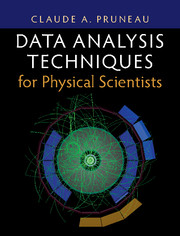Refine listing
Actions for selected content:
17002 results
Frontmatter
-
- Book:
- The Cosmological Singularity
- Published online:
- 24 October 2017
- Print publication:
- 26 October 2017, pp i-vi
-
- Chapter
- Export citation
Contents
-
- Book:
- The Cosmological Singularity
- Published online:
- 24 October 2017
- Print publication:
- 26 October 2017, pp vii-x
-
- Chapter
- Export citation
1 - Basic Structure of Cosmological Singularity
- from Part I - BKL Analysis
-
- Book:
- The Cosmological Singularity
- Published online:
- 24 October 2017
- Print publication:
- 26 October 2017, pp 7-31
-
- Chapter
- Export citation
Introduction
-
- Book:
- The Cosmological Singularity
- Published online:
- 24 October 2017
- Print publication:
- 26 October 2017, pp 1-4
-
- Chapter
- Export citation
Part II - Cosmological Billiards
-
- Book:
- The Cosmological Singularity
- Published online:
- 24 October 2017
- Print publication:
- 26 October 2017, pp 95-96
-
- Chapter
- Export citation
7 - Hyperbolic Coxeter Groups
- from Part II - Cosmological Billiards
-
- Book:
- The Cosmological Singularity
- Published online:
- 24 October 2017
- Print publication:
- 26 October 2017, pp 170-200
-
- Chapter
- Export citation
3 - On the Cosmological Chaos
- from Part I - BKL Analysis
-
- Book:
- The Cosmological Singularity
- Published online:
- 24 October 2017
- Print publication:
- 26 October 2017, pp 48-56
-
- Chapter
- Export citation

Data Analysis Techniques for Physical Scientists
-
- Published online:
- 24 October 2017
- Print publication:
- 05 October 2017
-
- Book
-
- You have access
- Open access
- Export citation

The Cosmological Singularity
-
- Published online:
- 24 October 2017
- Print publication:
- 26 October 2017
Conclusion
-
- Book:
- Unveiling Galaxies
- Published online:
- 06 October 2017
- Print publication:
- 12 October 2017, pp 233-246
-
- Chapter
- Export citation
Appendix
-
- Book:
- Unveiling Galaxies
- Published online:
- 06 October 2017
- Print publication:
- 12 October 2017, pp 247-252
-
- Chapter
- Export citation
2 - Portraying Cosmic Whirlpools
- from Part I - Images and the Cosmos
-
- Book:
- Unveiling Galaxies
- Published online:
- 06 October 2017
- Print publication:
- 12 October 2017, pp 17-33
-
- Chapter
- Export citation
9 - The Galaxy Classification Play-Off
- from Part III - Organizing the World of Galaxies
-
- Book:
- Unveiling Galaxies
- Published online:
- 06 October 2017
- Print publication:
- 12 October 2017, pp 185-186
-
- Chapter
- Export citation
Contents
-
- Book:
- Unveiling Galaxies
- Published online:
- 06 October 2017
- Print publication:
- 12 October 2017, pp v-vi
-
- Chapter
- Export citation
Copyright page
-
- Book:
- Unveiling Galaxies
- Published online:
- 06 October 2017
- Print publication:
- 12 October 2017, pp i-iv
-
- Chapter
- Export citation
7 - A Symphony of Waves
- from Part II - Images as Galaxy Discovery Engines
-
- Book:
- Unveiling Galaxies
- Published online:
- 06 October 2017
- Print publication:
- 12 October 2017, pp 131-149
-
- Chapter
- Export citation
11 - Atlases of Galaxies, Viewed by Their Users
- from Part III - Organizing the World of Galaxies
-
- Book:
- Unveiling Galaxies
- Published online:
- 06 October 2017
- Print publication:
- 12 October 2017, pp 205-232
-
- Chapter
- Export citation
1 - Viewing Heavenly Mist
- from Part I - Images and the Cosmos
-
- Book:
- Unveiling Galaxies
- Published online:
- 06 October 2017
- Print publication:
- 12 October 2017, pp 15-16
-
- Chapter
- Export citation
5 - The One-Thousand-Year Journey
- from Part II - Images as Galaxy Discovery Engines
-
- Book:
- Unveiling Galaxies
- Published online:
- 06 October 2017
- Print publication:
- 12 October 2017, pp 103-104
-
- Chapter
- Export citation
Introduction
-
- Book:
- Unveiling Galaxies
- Published online:
- 06 October 2017
- Print publication:
- 12 October 2017, pp ix-xvi
-
- Chapter
- Export citation
